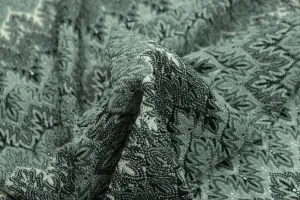Table of Contents
Garment Washing Chemicals
Garment washing chemicals play a vital role in different types of garment washing processes to achieve desired changes according to buyer requirements. However, there are lots of garment washing plants established in Bangladesh to do these garment washing processes. In the washing plant, different types of washing chemicals are used for this job. Basically, chemicals are found under different brand names, but the technician uses his best chemicals in the washing process. So, it is important to use accurate chemicals for the best performance. As a result, the user should have vast knowledge about the features of different types of garment and denim washing chemicals in their application area.

List of Garment Washing Chemicals and Their Functions
Garment chemicals are manufactured by different chemical and auxiliary manufacturing companies. Here, I have presented some garment washing chemicals’ name lists with their functions. I am sure these might help you select the correct chemicals for application. The following is a list of different garment washing chemicals and their functions. They are-
- Anti-Staining Agent
- Enzyme
- Acetic acid [CH3-COOH]
- Potassium Permanganate [KMnO4]
- Detergent
- Bleaching powder [Ca(OCl)CL]
- Caustic Soda [NaOH]
- Sodium hyposulfite [Na2S2O2]
- Soda ash [Na2CO3]
- Sodium bicarbonate [NaHCO3]
- Cationic or nonionic flax softener
- Micro Emulsion Silicon
- Salt
- Buffer
- Hydrogen peroxide [H202]
- Stabilizer
- Fixing agent
- Optical brightener
- Resin
- Wetting Agent
- Hygroscopic Agent
- Defoaming Agent
- Rubbing Fastness Improvers
- Sequestering Agent
- Stiffening Agent
- Chlorine Bleach
- Leakage
- Ant-Mildew Agent
- Bio Polishing
- Waterproofing Agent
Anti-Staining Agent
The anti-staining agent is one of the vital garment-washing chemicals. However, it is a pale yellow liquid in appearance and nonionic in nature. It is soluble in cold and hot water.
Functions:
- Firstly, the anti-staining agent can improve colorfastness after stone washing.
- Secondly, it has good dispersing, emulsifying, and absorbing abilities.
- Thirdly, these agents can prevent indigo back staining and improve color contrast and fabric brilliance for indigo dyes.
- After that, as it is highly concentrated, it dilutes before use, and a stable, diluted solution can be used easily.
- Lastly, if it uses an enzyme or general washing process, it improves the washing effect.
Enzyme
The enzyme is another important washing chemical, and it plays an important role. However, it is one of the most used chemicals in garment washing. Basically, different types of fashionable outlooks are added to the garments by enzyme washing.
Functions:
- Firstly, the ‘’anti-pilling’’ properties are improved by enzyme washing.
- Secondly, it gives a very smooth surface when it attacks the surface of the fabrics.
- Thirdly, catalyze enzymes can be used to remove residual hydrogen peroxide from the fabric after bleaching treatments.
- After that, the cellulose hydrolyzes by enzyme, and a faded effect is produced when it attacks the projecting fiber and the yarn portion inside the fabric.
- As a result, the GSM of the garment is reduced by enzyme washing.
- Then, the neutral enzyme is used for dark shades because it fades slowly.
- Afterward, it produces a soft feel in the fabric.
- Additionally, it helps to produce the fading effect in the sewing area.
- The acid enzyme is used for medium and light shades because it has an enzyme effect more quickly than a neutral enzyme.
- The bio-polishing effect on denim also produces an eco-friendly product.
- Lastly, enzymes increase the colorfastness and rubbing fastness properties of the garments.
Acetic Acid (CH3COOH)
Acetic acid is another garment-washing chemical. Basically, it is used in the textile industry for dyeing purposes. However, it is a colorless and corrosive liquid with a pungent smell. It is weak organic acid, the key ingredient in vinegar. Moreover, it has no adverse effects on the environment except for the use of oxygen for degradation because it is readily degradable.
Function:
- Firstly, acetic acid is a neutralizing compound used to neutralize the garment from the alkaline conditions and to control the pH value in the wash bath.
- Secondly, it is used in an enzyme bath.
- After that, it is often used for this purpose in professional laundries, although it is not a fabric softener in principle.
Potassium Permanganate [KMnO4]
A potassium permanganate solution is applied to the garments, which oxidizes the cellulose, and the color is partially removed according to the intensity of the solution. However, it is sprayed on the area of the garment after the de-sizing process. However, it helps color out from the garment during the enzyme wash.

Functions:
- Firstly, fading effects on garments are produced when rubbing a particular area of the garment by hand.
- It is mainly used for specific portion oxidizing in the garment industry.
- It is also used as a PP bleach in garment wash baths.
Detergent
Detergent is a washing chemical that helps remove impurities from garment fabric surfaces. It is the most used chemical in the washing industry. However, it applies in a specific temperature range, and temperature helps detergent enhance its action. It also develops fading effects on the garments.
Functions:
- Firstly, a detergent is commonly used as a cleaning agent in garment washing.
- Secondly, it removes stains, dust, and dirt.
- After that, it helps to improve water’s ability to wet things.
- Additionally, it improves the brightness of the washed garments.
- Lastly, it is also used in the de-sizing process.
Bleaching Powder
Bleaching agents are mainly used in the dyeing process in the pre-treatment stage. However, it helps to remove natural color from the fabric and makes it white from the natural gray color.
Functions:
- Firstly, it removes natural color from the garment.
- Secondly, it improves the brightness of the fabric.
- Lastly, it helps fabric be properly dyed.
Caustic Soda (NaOH)
Caustic soda is a strong alkali. However, it is mainly used for mercerizing cotton. Basically, it is a deliquescent white crystalline solid that readily absorbs moisture and carbon dioxide from the atmosphere.
Function:
- Firstly, it produces a fading or old-looking effect on garments rapidly.
- Secondly, it is used to introduce an alkaline condition in the washing bath.
- Lastly, it has cleaning power, which is more powerful than soda ash.
SODA ASH (Na2CO3)
Soda ash is an alkali, and it is a white crystalline solid containing water for crystallization. However, it has cleaning power for this It is used in laundry as a washing soda. It is also used for softening the water.
Functions:
- Firstly, it helps to create a color-fading effect on garments.
- After that, it creates an alkaline medium for the breakdown of pigment dye.
- It also has cleaning power.
Sodium Meta-Bi Sulfite
The chemical formula of sodium metabisulfite is Na2S2O5, and it is an inorganic compound composed of sodium, sulfur, and oxygen. Basically, it typically comes in a white or yellowish-white crystalline powder.
Functions:
- It is used as a bleaching agent as well as a reducing agent in pulp and textile manufacturing.
- It is used to neutralize the garment with potassium permanganate.
Hydrogen Peroxide
Hydrogen peroxide plays a vital role in the bleach wash technique. Basically, hydrogen peroxide breaks up and gives some perhydroxhylion in alkaline medium, which discolors the coloring materials and develops a fading effect. Moreover, hydrogen peroxide is used in scouring and bleaching baths in the pre-treatment stage to prepare gray fabric garments for dyeing. It is also used to neutralize the garment in an alkaline condition.
Function:
- It is best used in the home as an all-purpose cleaner.
- It uses it as an antibacterial and antifungal agent.
- It also kills mold and mildew.
Silicone Softener
Silicon softener is another important chemical in washing. We know that when a fabric is treated with different types of chemicals, it may lose its softness and become hard, which is not expected by anyone. So, it needs to make the fabric soft for better use. So, silicon softener can bring softening characteristics to the fabric, which can give comfort to the consumer.
Functions:
- It imparts softness with a wet feel to the body.
- It has excellent inner softness and a silky touch.
Pumice Stone
Pumice stone is commonly used in the garment washing process. However, when the impurities amount to 10% of a pumice stone, its density increases to 1 g/cm3. Then the stone will not float. Stone weight should be wt./fabric wt. = 0.5 to 3/1. Generally, the diameter of stone is 1–7 cm. On the other hand, moisture content should be less than 5%. Surface properties may be less than 5% fine. Also, the apparent density should be 0.5-0.75 g/cm3. Abrasion loss should be 35%. Moreover, large, hard stones last longer and may be suited for heavy-weight fabrics only; besides, smaller, softer stones would be used for light-weight fabrics and more delicate items.
Functions:
- This stone is used for washing purposes.
- Fading effects also come from pumice stone action.
Softener
Softener is another chemical for the washing process. Basically, the purpose of adding fabric softeners at the end of the process is to neutralize the very small amounts of detergents left in the textiles and thus prevent static electricity. However, when softener is applied to the garments, each and every tread slips over another.
Function:
- Firstly, softener creates a softer handle over the garments.
- Softener is used to give the treated textiles a surface feel that is both sickly and soft.
- Lastly, it also provides excellent lubricating properties.
Optical Brightener
Optical brightener is generally used to improve the brightness of garments. Two types of optical brighteners are used in the washing plant: red brighteners and blue brighteners. Optical brightener is applied to the fabric after the bleaching process. It improves the brightening properties of the textile materials.
Functions:
- It has brightening properties.
- It also helps to improve the value of fabrics in the market.
Wetting Agent
The wetting agent is mainly used to increase the wet property of the garments during the washing process. When this chemical is used in the washing bath, it helps other chemicals work properly during washing.
Rubbing Fastness Improvers
A rubbing-fastness improver is used to increase the rubbing-fastness of the garment.
Sequestering Agent
The sequestering agent is used to remove water hardness to make it easier to proceed with the washing process.
Waterproofing Agent
This chemical is used to protect water absorption.
Stiffening Agent
A stiffening agent is used to increase the hardness of the fabric.
Leakage Enzyme
Leakage enzyme is used to get the gray-cast color of the garments. However, we use this chemical when the garments and denim show too much blue but need a reddish or gray tone.
Anti-Mildew Agent
The anti-mildew agent is used to protect the garments from mold and mildew.
Bio Polishing
Bio-polishing is used in garment washing to remove brushes for its special action. However, after using bio-polishing, garments achieved more softness.
In sum, above all, chemicals are used in the garment washing process.
Worker Safety:
We know that chemicals are commonly used in wet processing technology. So, when we work with chemicals such as bleach, chlorine, or PP, be sure to protect workers by wearing masks and aprons, so it is best to be fully prepared. Besides, it is highly recommended to wear protective rubber gloves and safety glasses; these products can burn skin and eyes pretty badly. So, we should be careful about work safety in the chemical, dyeing, printing, or washing industries.





